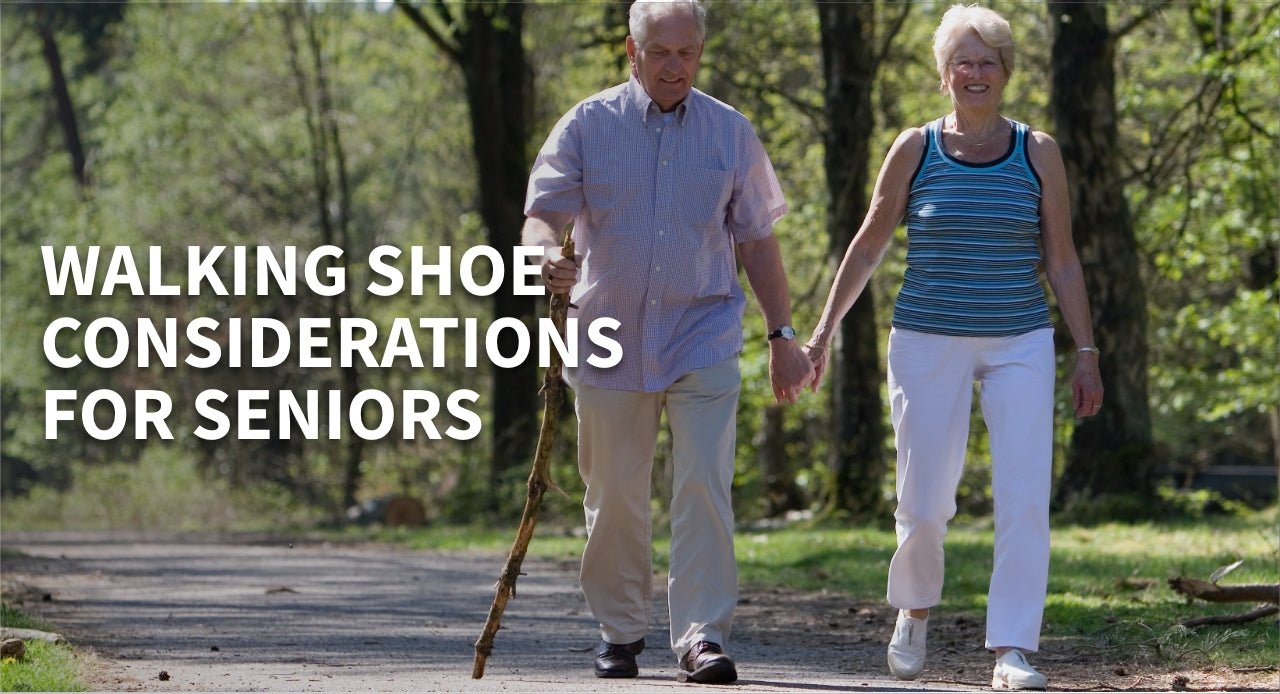Footwear
Aging Feet: Walking Shoe
Considerations for Seniors
Are you in the market for walking shoes that are perfect for seniors? Whether the pair is for you or a loved one in need of the perfect pair of walking footwear, you’ve come to the right blog.
We’ll guide you through the important factors to consider when purchasing walking shoes for yourself or a loved one. From finding the right fit to ensuring maximum support and traction, we’ve got you covered.
Plus, we’ll give you some style tips along the way.
So, let’s dive in and find the perfect pair of walking shoes for you!
free foot analysis
Overview of Walking Shoes
Wearing appropriate walking shoes meant and designed specifically for walking is essential for several reasons. First and foremost, walking shoes are specifically crafted to provide optimal support and cushioning for the foot and ankle. This is crucial as walking involves repetitive motion and places stress on these areas. Flat shoes can be harmful for anyone of any age, and can be especially damaging for the health of elderly walkers.
Although many shoe brands sell footwear specifically marked for walking, it’s worth mentioning that in this blog post, we’ll highlight the need to not limit your search to only those types of shoes.
For example, unlike running shoes, many of those walking shoes don’t need to be too light. So footwear marked for walking might actually be a bit too heavy sometimes for seniors. That is why seniors are recommended to also take a look at lightweight running or athletic shoes when deciding on a pair of shoes meant for frequent walking.
We know many seniors have health conditions or foot conditions that force them to look for specialized footwear that might not completely fit the definition of what a brand considers for walking. The key is to be open to any type of shoe or brand as long as several considerations or needs are met.
Benefits of Comfortable Walking Shoes for Seniors
Wearing comfortable and appropriate shoes for walking is crucial for seniors as it offers numerous benefits for their overall well-being.
A stable and comfortable pair of shoes provides proper support and cushioning, reducing the risk of falls or injuries because as seniors age, their balance, and stability often decline, making it easier for them to trip or stumble. By wearing comfortable shoes with good grip, traction, and sturdy soles, seniors can maintain better stability while walking, thus reducing the chances of accidents.
Comfy and supportive shoes alleviate foot pain and discomfort, which is common among seniors due to conditions like arthritis or neuropathy. These provide adequate arch support, cushioning, and a wide toe box, ensuring that the feet are properly aligned and reducing strain on the joints. This, in turn, promotes better mobility and allows seniors to engage in regular physical activity, which is essential for maintaining a healthy lifestyle and preventing various health issues associated with sedentary behavior.
Consideration when Looking for Walking Shoes for Seniors
What exactly should you be looking for in proper footwear for seniors and their walks? There are several considerations, from the cushioning to support and even materials. But each senior will have their own needs and priorities, and it is important to keep their foot health and overall health in mind before deciding what to prioritize.
Sole and Cushioning
For optimal comfort, make sure you choose walking shoes that offer proper support and cushioning. When it comes to walking shoes for seniors, these features are crucial to prevent discomfort and injuries.
Look for a pair that provides excellent cushioning in both the insole and midsole and arch support to reduce strain on your feet and ankles. Cushioning is also essential to absorb the impact when walking, reducing the risk of pain or fatigue. Look for footwear that comes with extra cushioning, gel cushioning, or other terms that might indicate a shoe has ample cushioning. You might also want to consider removable insoles or orthotic insoles that can be replaced after everyday wear and tear has made them thinner.
Moreover, choose a pair with a flexible sole to allow for natural foot movement. Remember, the right support and cushioning in your walking shoes can make all the difference in your comfort and overall walking experience.
Stability, Balance, and Shock Absorption
High-stability shoes are essential for any senior going on a walk, run, or even regular daily activities.
Consider shoes with a cushioned insole or midsole and a supportive heel counter and toe box.
There is a type of footwear called motion control shoes, normally used by runners and athletes for superior balance and support, which can be an excellent choice for active seniors or simply those who require extra stability. Motion-control shoes are normally used for people who overpronate but can also be appropriate for older wearers.
A senior’s arch type is a factor that should be known before going out and buying a new pair. For example, if an elder has suffered from flat feet, footwear with little to no support or arch can lead to debilitating pain.
As we mentioned before, running or athletic shoes—despite not being used for hiking or trekking through nature trails as intended—are a good option for older people who require much more support than normal for a walking shoe.
Proper Fit
When shopping for walking shoes, it’s important that they fit your foot shape properly to ensure comfort and reduce the risk of injury. An ill-fitted pair of shoes can cause blisters foot pain, and even lead to more serious issues like falls and sprains.
To find the right fit, start by measuring your feet when they are slightly swollen at the end of the day, as foot swelling is a common problem as we age. An experienced employee, like the team members at Lucky Feet Shoes, can also identify your foot type, focusing not just on size but the width of the toes, Try them on with socks that you would wear while walking. Walk around the store to check for any discomfort or tightness.
Ensure that there is enough room in the toe box for your toes to move freely. The shoes should provide adequate arch support and heel cushioning.
Slip Resistance and Traction
Slip resistance and traction are important factors to consider when choosing the right walking shoes for older adults. As you get older, your balance may not be as steady as it used to be, making it essential to have stable shoes that provide a good grip on various surfaces.
Look for a pair with non-slip soles or rubber outsoles that offer excellent traction, as they will help prevent slips and falls.
Consider wearing it with a tread pattern that can grip the ground effectively. This will give you added stability and confidence while walking. Tread patterns are especially common on a rubber outsole of running or athletic shoes, which can also be a good option for elderly people on their walks.
Materials
When it comes to walking shoes for seniors, the importance of lightweight but durable materials cannot be overstated. Materials that make for lightweight shoes ensure that the footwear does not weigh the feet down, allowing seniors to walk with ease and reduce fatigue.
Breathable materials are also important because many older people might suffer from common foot issues like swelling or arthritis, which leaves them feeling warm in the feet. Breathable shoes can alleviate this sensation. But for the colder months or in the case of seniors with poor circulation or other cardiovascular problems, the opposite might be true; they need thicker, more insulating materials to keep their feet warm.
The material also comes into play when considering how an older wearer will be able to clean and maintain their footwear. Look for machine-washable materials or only require a quick, effortless swipe from a paper towel or brush to keep clean.
Durability is also crucial to provide long-lasting support and protection for the feet. Seniors may encounter various surfaces and conditions while walking, and a durable shoe prevents wear and tear, offering stability and reducing the risk of injuries. When deciding to buy a pair of walking shoes for seniors, it is essential to prioritize a durable and lightweight shoe to enhance their comfort, safety, and overall walking experience.
Ease of Putting On and Taking Off
Getting the best walking shoes that are easy to put on and take off is crucial for older adults. Convenience is key when it comes to any choice for seniors, including footwear.
As we age, bending down and struggling to tie shoelaces can become challenging. Opting for shoes with Velcro straps, hook-and-loop closures, or slip-on designs can make your life much easier. These types of shoes allow you to effortlessly slide your feet in and out without any hassle, making an excellent choice for any older gentleman or lady.
Not only will this save you time and effort, but it also reduces the risk of accidents or falls. So, when you’re shopping for walking shoes, consider the ease of putting them on and taking them off. Your feet will thank you for it!
Bonus tip: The American Podiatric Medical Association (APMA) grants products a Seal of Acceptance and Seal of Approval that they've found promotes good foot health, so looking for this seal when you're shopping for the best walking shoes for seniors is a good idea.
Foot and Health Conditions To Consider When Buying Shoes for Seniors
There are several health and foot conditions that seniors must always keep in mind when going out for a new pair of walking footwear or whenever a loved one wants to purchase one for them. These health concerns and realities of aging will inform anyone when deciding which walking shoes for seniors to buy.
1. Arthritis: Seniors may develop arthritis in their feet, which can cause pain, stiffness, and limited mobility.
2. Diabetic neuropathy: Diabetes can lead to nerve damage, particularly in the feet, resulting in numbness, tingling, and loss of sensation. Specialized diabetic shoes might be the best choice for seniors in these cases.
3. Bunions: A bunion is a bony bump that forms at the base of the big toe, causing pain, swelling, and misalignment of the toe. In cases like these, footwear with a wider base will help ease these problems.
4. Corns and calluses: Thickened and hardened areas of skin, known as corns and calluses, can develop on the feet due to friction or pressure, leading to discomfort.
5. Plantar fasciitis: This condition involves inflammation of the plantar fascia, a band of tissue that runs along the bottom of the foot. It can cause heel pain and difficulty walking.
6. Foot deformities: As people age, they may develop foot deformities such as hammertoes (bent toes), claw toes (abnormally curled toes), or flat feet, leading to pain and difficulties in finding properly fitting shoes.
7. Fungal infections: Seniors may be more prone to fungal infections like athlete’s foot, which can cause itching, redness, and peeling of the skin on the feet.
8. Peripheral artery disease (PAD): PAD refers to the narrowing of arteries that supply blood to the legs and feet. It can cause leg pain, cramping, and poor circulation, leading to foot problems.
9. Osteoporosis: Seniors with osteoporosis have weakened bones, which can increase the risk of fractures or stress fractures in the feet.
10. Poor circulation: Aging can lead to decreased blood flow to the extremities, including the feet, resulting in cold feet, slow healing of wounds, and increased susceptibility to infections.
When you’re shopping for footwear, take into account the style and design options available to you or the senior you’re buying it for.
For seniors, walking shoes come in various styles that cater to different needs and preferences. Look for shoes that not only provide comfort and support but also reflect your personal style.
Whether you prefer a classic look or something more modern, there are plenty of options to choose from. Consider the color (or if they come in other color options), material, and overall design of the shoes.
Style and Design Considerations
Do you prefer a lace-up style or slip-on? Are you looking for a more casual or formal? Do you have an active lifestyle or only need them for everyday wear?
Ask yourself or your loved one these questions as part of any checklist when deciding for the proper footwear.
Frequently Asked Questions
Can Walking Shoes Help Alleviate Foot Pain and Discomfort in Seniors With Conditions Like Arthritis or Plantar Fasciitis?
Walking shoes can help alleviate foot pain and discomfort in seniors with conditions like arthritis or plantar fasciitis.
Look for features like cushioning, arch support, and a roomy toe box.
Are Any Recommended Brands or Models of Walking Shoes Particularly Well-Suited for Seniors?
When buying walking shoes for seniors, it is important to consider recommended brands or models that are well-suited for their needs. These shoes can provide ample cushioning and support, especially for conditions like arthritis or plantar fasciitis. Out of the major shoe brands, Brooks and New Balance are known for their cushioned shoes with a lot of stability, lightweight materials, and focus on everyday comfort.
How Often Should Seniors Replace Their Walking Shoes to Ensure Optimal Support and Cushioning?
You should replace your walking shoes regularly to maintain optimal support and cushioning. Overall, walking shoes are replaced about every 300-500 miles, which comes out to every 6 months to a year. But this might be a bit longer in the case of older people who might not use them as much.
Once the midsole lacks responsiveness or feels like a flat sole, you know it’s time to change. Ensuring you have a supportive midsole is essential to avoid discomfort and reduce the risk of injuries.
Are There Any Specific Walking Shoe Features That Can Accommodate Seniors With Wide or Narrow Feet?
Look for footwear with adjustable straps or laces. These features allow for a customizable fit, ensuring the shoes are not too tight or loose. There are also models that come in different width options. This means that seniors with wide feet can find shoes that provide enough room for their feet to feel comfortable and supported. Conversely, seniors with narrow feet can look for a more snug-fit pair.
By considering these features, seniors can find walking shoes tailored to their specific foot width, promoting comfort and stability.
Request Your Personal Fitting
Jerick Sobie
Since 2005, I have been a dedicated small business owner specializing in footwear retail. With over 20 years of experience, my business partner and I have helped customers find the perfect shoes that combine style, comfort, and quality. Our expertise extends beyond local sourcing—we have traveled internationally to discover high-quality footwear that meets our customers’ needs. In addition to running my business, I have participated in numerous health fairs and educational seminars, sharing my knowledge on proper footwear and foot health. Committed to providing exceptional service, We carefully curate our selections to ensure the best fit and support for every customer.






















